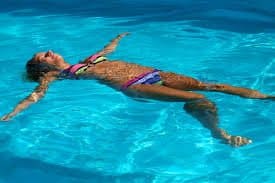1. PICK A POOL
There are three main types of inground pools. In order of popularity they are: concrete, vinyl-lined and fiberglass. In small pockets of the country, you might also find contractors building steel- or aluminum-walled pools.
Concrete pools are truly custom-built and can be formed to virtually any size or shape. These types of pools are often called Gunite or Shotcrete pools because concrete is shot from a gun onto steel-reinforced walls. Once the concrete cures, it’s either plastered smooth, painted, finished with a textured aggregate surface or tiled. Alternatively, a smaller percentage of concrete pools are formed and poured in a way similar to a house foundation. This technique, called structural concrete, is often used for pools built into hillsides.
It typically takes longer to install a concrete pool than any other kind—generally between three and 12 weeks—but it’s considered the strongest, most durable type of pool. In fact, there are many concrete pools still in use today that are well over 50 years old. And, unlike any other type of inground pool, existing concrete pools can be remodeled, enlarged and updated.
Vinyl pools are made from a preformed flexible liner that fits into the hole and attaches to a reinforced wall frame made of steel, aluminum or non-corrosive polymer. Most vinyl pools are rectangular, but L-shaped and freeform liners are also available. And vinyl liners come in dozens of patterns and colors to satisfy anyone’s personal preference or poolscape design.
When considering a vinyl pool, be aware that pool toys, pets and sharp objects can puncture the liner. And while liners can be repaired, play it safe by choosing one that’s at least 20 to 30mm (about 1 inch) thick. Construction time for a vinyl-lined pool is generally one to three weeks.
Fiberglass pools are factory-molded into one giant bowl-shaped piece, which is set into the excavated hole by a crane. As a result, fiberglass pools can be installed much faster than other pool types. In some cases, installation takes as little as three days.
Fiberglass pools have a supersmooth gel coat finish that’s extremely durable and stain resistant. Unlike concrete, fiberglass pools are nonporous, so they tend to use fewer chemicals and harbor less algae.
However, fiberglass pools come in fewer sizes and shapes than concrete or vinyl pools. And the huge molded pools must be shipped via truck, which are often forced to take long, circuitous delivery routes. “The transportation of oversized loads is regulated by individual states,” explains Suzanne Barrows of the Association of Pool and Spa Professionals. “Therefore, truckers will often have to drive around several states to deliver a fiberglass pool.”
How a fiberglass pool gets to your house isn’t your responsibility, but there must be adequate space in your yard for the crane to drive to the pool site.
All three types of pools—concrete, vinyl and fiberglass—are available nationwide. However, some types are more prevalent than others in certain regions. The flexibility of fiberglass and vinyl liners makes them ideal for very cold climates where winter freezing and thawing cycles can damage a rigid concrete structure. Vinyl pools are sold in most areas, yet fiberglass is most popular in the south. Not sure which type of pool is best for you? Rely on the expertise of local pool contractors. If they’re all installing the same type of pool, it’s probably for a good reason (it often has to do with the local climate and soil conditions).
2. COMPARE PRICING
It’s difficult to say how much you’ll pay for an inground pool. Cost varies widely depending on the region of the country, type of pool, soil condition, circulation system, accessories and, of course, the size and shape of the pool. Even the time of year can influence the price; some contractors offer discounts for pools built during the off-season when business is slow.
Generally speaking, concrete pools are the most expensive, followed closely by vinyl-lined pools, and then fiberglass. However, a high-end, tricked-out fiberglass pool could cost more than a barebones concrete pool.
I can tell you that here in New England, my neighbor—and new best friend—Bob paid nearly $40,000 for a 20- x 40-ft. concrete pool. That price included the filtration system, initial water fill-up, underwater lights and stone coping around the pool’s edge, but not the cost of the fencing, landscaping and other pool-related items. When determining the total cost of a pool, take into account these not-so-incidental expenses (see Step 6).
“Our customers typically spend about twice the pool cost to complete their swimming pool project,” says Tommy Johnson, owner of Johnson Pools and Spas in Huntsville, Ala. “If you buy a $50,000 pool, be prepared to spend an additional $40,000 to $50,000 before all is said and done.”
3. CHECK WITH ZONING
Inground swimming pools are subject to building and zoning regulations just like any other home-improvement project. Therefore, you must apply for a building permit and receive approval before any work can begin.
Building and zoning rules differ from town to town, but ordinarily you must satisfy certain setback distances from the pool to property lines, septic tanks, wells, sewer lines, wetlands and the like. There are also codes concerning pool barriers and gate hardware.
Generally, a perimeter wall or fence must be at least 4 ft. tall and equipped with self-closing, self-latching gates. Fence boards or balusters must not be spaced more than 4 in. apart. Chain-link fences must have openings no larger than 1-1/4 in. wide.
For an extra level of protection, especially if you’ve got young children or grandchildren, consider mounting alarms on all house doors and gates leading to the pool, and installing a power safety cover over the pool. For a list of specific rules and restrictions, contact the local building department or zoning board.
4. SITE THE POOL
Picking the proper spot for your inground pool is as important as the pool itself. An experienced pool contractor can provide valuable insight, but be sure to consider the following pool-placement tips:
* Let the Sun Shine In: Take advantage of free solar energy by picking a pool location that’s open to the sun and well away from any trees. Such a location will not only warm up the water, it’ll also reduce the number of leaves that drop into the pool.
* Block the Breeze: Building a pool in a windy location greatly increases water evaporation, which means you’ll constantly have to add pool water to maintain the proper level. Strong winds can also make you feel uncomfortably cool when wet. Create a windbreak by erecting a solid-board fence, or by planting a row of thick shrubs or trees.
* Stay High and Dry: Avoid building in a low-lying area, which could result in the pool flooding with mud and debris during periods of heavy rain. Also avoid areas with a high water table; rising groundwater will flood the deep end of the excavated hole.
* All Clear Above and Below: The pool shouldn’t be located beneath overhead telephone or electrical wires, or directly over buried sewer lines, septic systems or electrical cables.
* Keep Eye Contact: Whenever possible, build the pool within view of the house. That way, you can keep an eye on swimmers even while you’re indoors.
* Accommodate Accessories: When determining pool placement, be sure there’s enough room for installing accessories, such as a whirlpool spa, slide, diving board, bench seats and utility shed.
5. CHOOSE A CIRCULATION SYSTEM
The pool’s circulation system is designed to keep the water clean and crystal clear. To do this effectively, it uses both filtration and sanitization. The heart of the filtration system is the pump. This draws water from the pool’s bottom drains, sends the surface water through an automatic skimmer, and then passes everything through a filter before recirculating it to the pool. There are three types of filters commonly used: sand, cartridge and diatomaceous earth (DE).
All three types of filters work well when properly installed and well maintained. An experienced contractor will help you decide which filtration system is best for your pool.
Sand filters are the oldest and most common method of pool-water filtration. They use special filter sand to trap dirt and debris. As the sand particles “load up” or become clogged, they trap smaller and smaller particles. Sand filters are cleaned by backwashing, which involves reversing the water flow through the filter and flushing the dirty water into a waste line.
Cartridge filters have been around for a number of years, but their popularity has only recently begun to skyrocket. This system uses large cylindrical cartridges to screen out dirt. Most pool builders recommend using large cartridges that have 500 to 600 sq. ft. of filter area. Unlike sand filters, cartridges don’t require backwashing. Instead, you simply remove them and rinse off the dirt with a garden hose, a process that uses much less water than backwashing. In fact, backwashing has become an environmental issue in the southwest and other drought-prone areas of the country.
“If every inground pool owner in the greater-Phoenix area used cartridge filters,” states Kevin Woodhurst of Premier Pools in Chandler, Ariz., “we’d collectively save about 1.5 billion gallons of water each year.”
Diatomaceous earth is a porous powder that has microscopic openings, similar to tiny sponges. As water passes through the openings, particles are trapped. DE filters can strain out dirt, dust, algae and some forms of bacteria. When DE filters become dirty, they’re cleaned by backwashing but use far less water than sand filters. Afterward, fresh DE is added to the filter. A filtration system removes debris, but a chemical sanitizer is required to kill organic contaminants, such as bacteria and algae. And an oxidizer is used to kill both inorganic and organic contaminants. There are three EPA-registered sanitizers commonly used in swimming pools: chlorine, bromine and PHMB.
Chlorine is by far the most commonly used pool sanitizer; it’s also an effective oxidizer. When dissolved in water, chlorine releases free-available chlorine, also known as hypochlorous acid. There are different kinds of chlorine sanitizers available, including cal hypo, dichlor, gaseous chlorine, liquid chlorine, lithium hypochlorite and trichlor. Bromine (hypobromous acid) tablets can also be used as a pool sanitizer. The solid white tablets slowly dissolve to produce free-available bromine, which is also a strong oxidizer. PHMB (polyhexamethylene biguanide) is a pool sanitizer that’s used in conjunction with hydrogen peroxide and an algaecide. Hydrogen peroxide is used as an oxidizer.
Salt chlorine generators represent the very latest advancement in pool sanitization. Instead of using standard pool chlorine, this system transforms common table salt into chlorine. Contrary to what you may have heard, salt chlorine generators don’t create saltwater swimming pools.
Note that it’s important to test the pool water before adding chemicals arbitrarily. Take a water sample to a local pool store for analysis, or buy a do-it-yourself test kit. “Keep the pH between 7.2 and 7.8, and maintain the alkalinity between 80 and 120 parts per million,” recommends Kevin Woodhurst of Premier Pools. During the summer’s very hottest stretches, check the water chemistry several times a week. “Keeping the pool water properly balanced is the very best way to control sanitizer consumption,” advises Woodhurst.
6. BEWARE OF BUDGET-BUSTERS
As mentioned earlier, the true price of an inground pool is often about twice the cost of the pool itself. That’s because there’s so much more to an inground pool than a hole filled with water: You need to enhance the landscape, buy accessories and invest in pool maintenance.
Here’s a list of items that aren’t typically included in the price of the pool: outdoor lighting, landscaping, pathways, decks, fencing, patios, privacy screens, whirlpool spas, outdoor sound system, water test kits, shade structure, patio furniture, equipment shed, storage cabinet, pool toys, additional outdoor electrical outlets and telephone line.
You’re not likely to need all of these items, but keep them in mind when formulating your construction budget.


